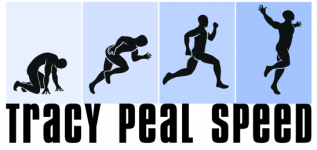LAB RAT: A Tale in Two Parts
ACT 1: I’ve heard a lot about biomechanist Irene Davis and the Running Injury Clinic at the University of Delaware. Dr. Davis’ “research is aimed at understanding the relationship between the lower extremity structure, mechanics and injury.” I recently learned that Davis and her students were soliciting barefoot/minimalist runners to participate in a footstrike study the lab was now conducting. Intrigued, I contacted the lab and scheduled my appointment. There, I met PhD candidate Allison Altman, who had me fill-out a release form before outfitting me with a myriad of motion sensors on my hips, lower torso, knees, ankles and feet. Afterwards, she explained the test guidelines: after a brief warm-up, I was to run 5 minutes in my current running style (forefoot), then 5 minutes on the midfoot before 5 more minutes while heel-striking. Finally, Allison would watch me run in my bare feet for a final 5 minute interval.
Donning a pair of retro Nike Air Pegasus (because of their neutrality, she told me), I ran my initial 5 minutes hyper-focused on my forefoot landing: the rigid, over-cushioned awkward-fitting shoe inhibiting my ability to feel the ball of my foot. The next five proved even more challenging as I attempted to locate my midfoot (an anomaly I’ve argued against in a previous blog). Allison tried to quell my confusion, explaining the midfoot as a neutral landing of my whole foot. A simultaneous crash landing, I joked. She did a good job coaching me through it, cuing me whenever my forefoot began to sneak ahead of my heel. After another rest break, it was time for the 5 minutes of heel-striking. Ironic how I was now emulating that despicable heel-toe pattern I’ve fought against for so long. In retrospect, though, I’m glad I had an opportunity to step back into heel-striking mode. Feeling totally uncomfortable, despite Allison’s urges to “pull my toes up more,” my stride floundered, quads tightened, hip flexors strained as I continued to reach forward. With each irregular step, I never wished so emphatically for my feet to be free. I found it difficult to comprehend why anyone would run this way, forgetting that without my present knowledge, I would be that same person. Needless to say, my final barefoot period was nirvana, as I rhythmically pulled my feet from the conveyor belt. There was an immediacy to every step I took – something that science fails to translate.
ACT 2: I received a frantic voicemail from my friend, Sally Higgins, a PT and newbie Pose Coach. Sally sounded so incredulous as she described what she had heard the night before at a free lecture given by Dr. Irene Davis. As the story goes, Dr. Davis answered Sally’s inquiry as to Davis’ thoughts about Dr. Nicholas Romanov’s Pose Method and its application to minimalist running, by stating “how bad his [Romanov’s] science is.” She further added that it none other than Chris McDougall (Born To Run) who had “changed her mind” about the possibility of landing on the forefoot…How strange, considering that McDougall, a writer, backed into being the poster-boy for the barefoot running craze, while acknowledging to not being an authority on running mechanics. Not surprisingly, McDougall had gone to Romanov in Florida to correct his form, and even had sessions with Romanov-devotee, the Brit Lee Saxby. For Davis to so abruptly dismiss and denigrate the Pose model, while backhandedly endorsing the minimalist/forefoot ideology, is ultimately irresponsible. Again, this points towards science taking a reductionist approach to observing a complex topic (Even Altman had argued, in a phone conversation prior to our meeting, that the lab was concerned with “biomechanics, not efficiency”). Unfortunately, behind this facade of inconclusive data and a dearth of common sense, scientists like Davis are able to mold the public perception of running technique. A week later, Higgins heard McDougall (to his credit) denounce Davis’ “science” and supported the tremendous benefit of the Pose Method towards efficient, pain-free running. With all of the information available to us, do we really need someone who champions “the technological advancements [in running shoes] over the last 30 years” to tell us how to run?







